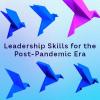Business Transformation Requires Transformational Leaders
Leadership and teaming skills are front and center in times of rapid change. Meet today’s constant disruption head on with expert guidance in leadership, business strategy, transformation, and innovation. Whether the disruption du jour is a digitally-driven upending of traditional business models, the pandemic-driven end to business as usual, or the change-driven challenge of staffing that meets your transformation plans — you’ll be prepared with cutting edge techniques and expert knowledge that enable strategic leadership.
Subscribe to Arthur D. Little's Culture & Leadership Newsletter
Insight
This Executive Update explores CIO lessons learned from the COVID-19 pandemic and how we can better prepare for the next crisis.
Cutter Expert Esther Derby, Dave Martin, and Tony Ponton present an interesting comparison between organizations that adapted during the pandemic and those that did not. They also suggest remote governance based on the SEEM model (steering, enabling and enhancing, and making).
Lori Silverman explains how leaders can use stories to create greater engagement with staff. She says that seeking different communication patterns enhances relationship building and reverses stress levels in some team members. Silverman demonstrates how executive storytelling can be used to establish direction and motivate teams.
Al Shalloway’s article outlines how leadership’s focus must switch from the people to the processes — the value streams by which the organization operates. He believes leaders can enhance customer experience, increase innovation, and reduce costs with this approach.
In this edition of Amplify, our contributors discuss the effects of the pandemic from their viewpoints. With such a dramatic disruption to business worldwide, many leaders found they had to quickly unlearn how they had operated over the past 20 or 30 years and adapt to the new normal.
It’s one thing to talk about new ways of working and cultural change, but the actions of the leader count. Bob Galen asks, “How are you showing up?” Galen suggests that changing yourself is a more decisive action to enable your people. He asserts that culture shaping happens whether by design or not, so it’s far better for leaders to be aware of this fact and act intentionally.
The authors suggest that although none of us would choose a 10-year-old computer for our work today, many executives persist in using outdated leadership models and behaviors. They say leaders who want to elevate their capabilities must start by knowing why they lead, then update their behavioral algorithm using the Innovative Leadership framework.
Teamwork effectiveness models are based on accumulated empirical observations and reasoned arguments, and identify and describe key factors necessary for effective teamwork. Our model, tailored for Agile practitioners, offers insights into effective Agile teamwork and explains how certain Agile practices support it.

























